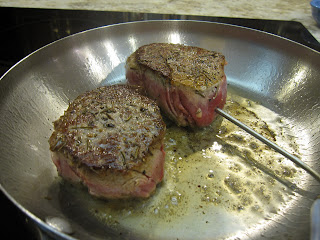I hope everyone had a wonderful holiday! Now, I know I have only really blogged about desserts and sweet items, so I decided it was time to switch things up a bit.... with MEAT!
Now I know what you're thinking... a Nutrition student? and red meat? Don't get me wrong, I am a firm believer in
incorporating more vegetarian and plant based meals into one's diet as part of a healthy lifestyle. I myself experiment with vegan and vegetarian options now and again, but sometimes, a girl just needs a big slab of meat! So that's just was a had for Christmas Eve Dinner!
The big piece of meat pictured above is actually a portion of
Buffalo (aka: Bison) Tenderloin. Personally, I prefer to have Bison over Beef any day, for a number of reasons, one being it is a leaner cut of meat. So I also feel that this is a good opportunity to go through of a few differences between beef and bison.
1. I will start with the obvious:
 |
| Bison Beef |
Glad we cleared that up!
2. Unlike most cows raised for consumption, bison usually spend their whole life
roaming freely in grass and feed on mostly grass and hay.
3. To find beef that has been grass fed similar to bison is usually a challenge in most grocery stores, unless you go to a more specialty grocer, such as Whole Foods. Even then, grass fed beef is almost always more expensive.
4. If you are worried about there being
antibiotics and growth hormone residues being in your food supply, then there is nothing to worry about with bison! Bison are not given these icky chemicals while they are raised.
5. The nutrition profile of bison is also better than beef. Because bison are able to graze and roam freely, their meat is
very lean and tender, especially the tenderloin portion. Therefore, there is less saturated fat in one ounce of bison, compared to one ounce of beef, which is great news for your arteries!
Overall, bison is similar in flavor and tenderness to that of beef, but with less fat! For more information on bison, check out
this link!
So if you're ever in the mood for some red meat, I hope you will give bison a chance! Below is the "recipe" for my favorite way to cook bison! Hope you enjoy!
Print this recipe!
Pan Seared Bison
Ingredients
- 2, 6-oz. bison tenderloin filets, about 2'' thick
- 1/2 teaspoon salt
- 1/2 teaspoon pepper
- 1 teaspoon dried rosemary
- 1/2 tablespoon olive oil
- 1/2 tablespoon butter
Probe Thermometer (optional)
Directions
Rinse and pat dry your bison steaks. Evenly season bison with salt, pepper, and rosemary.
If using a probe thermometer, insert the probe into the thickest portion of the meat, ensuring the probe is centered in the middle of the steak.
In a sauté pan over medium-high heat, add the butter and oil. Allow the butter to melt and for the mixture to get very hot and slightly browned.
Add the steaks to the hot pan, and brown on all sides.
Once brown, transfer steaks to an oven-safe pan and bake at 350 degrees F for about 15 - 20 minutes for medium.
If using a probe thermometer, cook until internal temperature reaches 135 - 140 degrees F (medium rare - medium).
Remove filets from oven and let rest on counter for 5 minutes before serving.
Note: the butter/ oil pan is a great starting place for making a wine sauce for the bison, after it is browned! Reduce your favorite red wine down in the pan with either arrowroot or flour as a thickener. Finish sauce with butter and serve with bison!





















